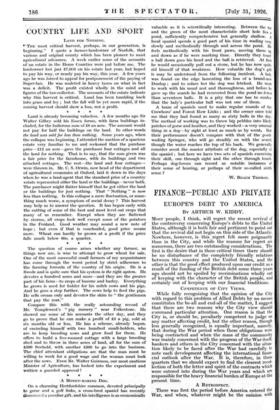Land is already becoming valueless. A few months ago Sir
Walter Gilbey sold his Essex farms, with farm buildings in- cluded, for the ludicrous sum of 28 an acre. The amount would not pay for half the buildings on the land. In other words the land was sold for less than nothing. Some years ago, when the collapse was beginning, I attended the auction of a spacious estate very familiar to me and reckoned that the purchase price-212 an acre—gave the purchaser four cottages and all the land for nothing. That is to say, that the sum given was a fair price for the farmhouse, with its buildings and two attached cottages. The rest—the land and four cottages— were thrown in. Mr. C. S. Orwin, now head of the department of agricultural economics at Oxford, laid it down in the days when he was a land-agent that the standard price of a country estate represented either the land or the buildings—never both. The purchaser might flatter himself that he got either the land or the buildings for just nothing. That " Nothing " is now less than nothing. Is this collapse a mere fluctuation, or some- thing much worse, a symptom of social decay ? This harvest may help us to answer the question. It has begun early with the cutting of some of the best and most level oat crops that Many of us remember. Except -when they are flattened by storms, all crops look well except some of the potatoes in the Fenland. Good weather may sound a new note of hope ; but even if that is vouchsafed, good price means more. Wheat can hardly be grown at a profit if the price falls much below 60s. a quarter.- -
* *


































 Previous page
Previous page